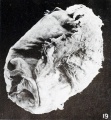File:Mall Meyer1921 fig19.jpg: Difference between revisions
No edit summary |
|||
| Line 6: | Line 6: | ||
{{Mall_Meyer1921Plate2}} | |||
{{Carnegie56 TOC}} | |||
Latest revision as of 17:07, 24 November 2012
Fig. 19. External appearance of chorion containing small nodular twin
No. 7886. Xl.15.
One of the most interesting of these nodular embryos is No. 7886, received from Dr. Anfin Egdahl, shown in figure 19. This is one of double-ovum twins in which the chorionic vesicles were wholly distinct. The smaller of the twins is but 2 mm. long, with a greatest diameter of about the same dimension. The mate, on the contrary, is relatively a normally formed, somewhat stunted fetus, with a crown-rump length of 17 mm. The abortus containing the chorionic vesicle with the little nodule was somewhat larger than the one containing the fetus, although both chorionic vesicles were covered by approximately the same quantity of decidua. The dimensions of the chorionic vesicle belonging to the stunted embryo were 60 by 45 by 40 mm., and those of the one containing the nodular embryo 65 by 55 by 40 mm. The greater size of the latter was due probably to the greater distension of the chorionic membranes, which are thinner and possess only poorly developed villi. The other vesicle, on the contrary, shows very definite placental development, although one of its dimensions actually was smaller than the corresponding dimension of the chorionic vesicle belonging to the small nodule. Both specimens evidently were very decidedly macerated when aborted.
- Plate 2: Fig. 12 | Fig. 13 | Fig. 14 | Fig. 15 | Fig. 16 | Fig. 17 | Fig. 18 | Fig. 19 | Chapter 4 Pathologic analysis
| Embryology - 16 Apr 2024 |
|---|
| Google Translate - select your language from the list shown below (this will open a new external page) |
|
العربية | català | 中文 | 中國傳統的 | français | Deutsche | עִברִית | हिंदी | bahasa Indonesia | italiano | 日本語 | 한국어 | မြန်မာ | Pilipino | Polskie | português | ਪੰਜਾਬੀ ਦੇ | Română | русский | Español | Swahili | Svensk | ไทย | Türkçe | اردو | ייִדיש | Tiếng Việt These external translations are automated and may not be accurate. (More? About Translations) |
Mall FP. and Meyer AW. Studies on abortuses: a survey of pathologic ova in the Carnegie Embryological Collection. (1921) Contrib. Embryol., Carnegie Inst. Wash. Publ. 275, 12: 1-364.
- In this historic 1921 pathology paper, figures and plates of abnormal embryos are not suitable for young students.
1921 Carnegie Collection - Abnormal: Preface | 1 Collection origin | 2 Care and utilization | 3 Classification | 4 Pathologic analysis | 5 Size | 6 Sex incidence | 7 Localized anomalies | 8 Hydatiform uterine | 9 Hydatiform tubal | Chapter 10 Alleged superfetation | 11 Ovarian Pregnancy | 12 Lysis and resorption | 13 Postmortem intrauterine | 14 Hofbauer cells | 15 Villi | 16 Villous nodules | 17 Syphilitic changes | 18 Aspects | Bibliography | Figures | Contribution No.56 | Contributions Series | Embryology History
| Historic Disclaimer - information about historic embryology pages |
|---|
| Pages where the terms "Historic" (textbooks, papers, people, recommendations) appear on this site, and sections within pages where this disclaimer appears, indicate that the content and scientific understanding are specific to the time of publication. This means that while some scientific descriptions are still accurate, the terminology and interpretation of the developmental mechanisms reflect the understanding at the time of original publication and those of the preceding periods, these terms, interpretations and recommendations may not reflect our current scientific understanding. (More? Embryology History | Historic Embryology Papers) |
File history
Click on a date/time to view the file as it appeared at that time.
| Date/Time | Thumbnail | Dimensions | User | Comment | |
|---|---|---|---|---|---|
| current | 14:30, 24 November 2012 |  | 808 × 875 (134 KB) | Z8600021 (talk | contribs) | ==Fig. 19. External appearance of chorion containing small nodular twin== No. 7886. Xl.15. :'''Plate 2''': Fig. 12 | Fig. 13 | [[:File:Mall_Meyer |
You cannot overwrite this file.
File usage
The following 2 pages use this file:
